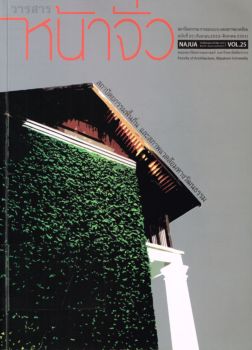บ้านและเรือนพวนเชียงขวาง: การย้อนกลับมาตั้งถิ่นฐานใหม่ในพื้นที่เดิม
Keywords:
ชาวพวนเชียงขวาง, สปป.ลาว, หมู่บ้าน, เรือนพื้นถิ่น, Phuan Xiangkhoang, The Lao PDR, village, vernacular houseAbstract
การศึกษาบ้าน และเรือนพวนเชียงขวาง ในเนื้อหาของการย้อนกลับมาตั้งถิ่นฐานใหม่ในพื้นที่เดิม มุ่งหวังที่จะศึกษาและค้นหาการปรับตัวของชาวพวนเชียงขวาง ซึ่งย้ายถิ่นออกจากพื้นที่เดิมเพราะภัยสงครามหลายทศวรรษ และเพิ่งย้อนกลับมาตั้งถิ่นฐานใหม่ในพื้นที่เดิม หรือพื้นที่เกี่ยวเนื่องกับแหล่งที่ตั้งเดิมตั้งแต่ พ.ศ. 2518 เมื่อประเทศลาวเกิดความสงบพ้นจากสงครามภายนอกและปรับเปลี่ยนการปกครองเป็นสาธารณรัฐประชาธิปไตยประชาชนลาว จากการศึกษาเอกสารทุติยภูมิผนวกกับการสำรวจภาคสนาม โดยอาศัยฐานจากแผนที่และภาพถ่ายทางอากาศ และการสัมภาษณ์เ ชิงลึกชาวบ้านในหมู่บ้านใหม่และผู้ปกครองท้องถิ่น ได้พบว่า ชาวพวนได้มีการปรับตัวเพื่อให้ชีวิตและสภาพแวดล้อมมีความสมดุลทั้งในระดับบริบทระดับหมู่บ้าน และระดับเรือน การปรับตัวในบริบทมีทั้งการปรับวิถีการเกษตรในบางพื้นที่ ปรับการผลิตข้าวไปตามระบบการปกครองที่บังคับอยู่ มีการใช้ภูมิปัญญามากมายในการจัดการนํ้าทั้งภูมิปัญญาดั้งเดิมและภูมิปัญญาใหม่ในระดับผังหมู่บ้านได้ปรับตัวที่จะอยู่ร่วมกับรูปพรรณสัณฐานหมู่บ้านใหม่ที่เป็นแนวยาวตามระบบสาธารณูปโภคของรัฐ และในระดับเรือนพักอาศัย มีการปรับเปลี่ยนรูปแบบของผังพื้นเรือนจากการใช้ครัวกลางเรือนเป็นครัวท้ายเรือน ซึ่งวิเคราะห์ว่า น่าจะรับอิทธิพลจากเรือนเวียงจันทร์ถิ่นที่พักพิงของชาวพวนอพยพหลายทศวรรษ
Abstract
The study of villages and vernacular houses of the Phuan in Xiangkhoang which have been resettled in their previous location or its vicinity on 1975 afl er facing battle conditions for several decades, emphasized on searching the adaptability of The Phuan in Xiangkhoang from 1975 when their political condition changed The Laos to The Lao People’s Democratic Republic from triangulation method of study : secondary document, fi eld survey with aerial photography and map based, and indept-interview from local people and local governor, it was found that The Phuan in Xiangkhoang adapted themselves in several levels of living, from natural context, especially developed their water management system to both terraced rice farming for sloping terrain and paddy fi eld for the low land, together with the adaptation for the changing of rice producing policy of The Lao PDR Government. For the village and houses level, The Phuan have to adapt their interrelation of social kinship system from clustered village to lenear village which varied from the new road system. The Phuan vernacular houses have been changed their fl oor planning by moving their hearth (kitchen fi re place) from their central living to be the ended kitchen. This change should be infl uenced from the Vientiane house which were their migrating stop for several decades. Whether The Phuan in Xiangkhoang faced several contents and level of adaptation in their living, lots of old and new local wisdom can still assist their living in natural context.





